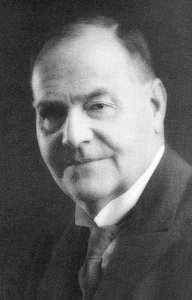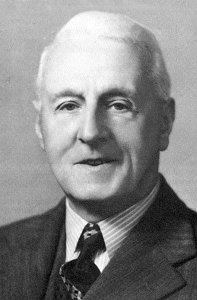The Villiers Engineering Co. Ltd.
A short history of the
company
Background and beginnings
In the 1890s John Marston's Sunbeam bicycles became
extremely successful. From the start they had relied on high quality
of production and finish. But John Marston was dissatisfied with the
pedals on his machines, which he bought in. In 1890 he dispatched his
son Charles to the USA on a selling trip but included in his instructions
that Charles must discuss pedal engineering with Pratt and Whitney in
Hartford, Connecticut and come back with a high class pedal and the
machinery for making it. Whether or not he visited Pratt and Whitney and got
machinery there is not clear but Charles himself said that the Villiers
Engineering Co. was "the ultimate fruit" of his trip to the US.
|

Sir Charles Marston. |
What seems to have impressed him there was the
production system and the labour saving devices. He pointed
out that "it was not possible to develop these at Sunbeamland, which
had long been working on another plan, but it was possible to start
them in a new factory". Presumably this refers to the fact
that Sunbeamland had developed, and continued to be developed, on
the old courtyard factory plan which was not amenable to flow, or
assembly line, production. In 1898 they acquired "a
small japanning shop and three cottages" in Villiers Street.
How small the shop was is not clear as they had belonged to Edward
Bullivant, a producer of japanned ware on quite a large scale.
In
any event they were big enough to convert into offices and factory
and for eight men to be employed there. Charles Marston was
put in charge of this factory, though most of his time was still to
be spent at Sunbeamland. The company was registered as the Villiers
Cycle Component Company with Charles Marston as the Managing
Director. |
| The new machinery and production methods proved to be a
success - such a success that they produced more pedals than Sunbeam
needed. It was decided to sell the surplus to other bicycle
makers. This decision was to turn Villiers from an in-house
component shop into a major manufacturer in its own right. Charles
appointed Frank Farrer, who was then the manager of the Palmer Tyre
Company's Coventry depot, as sole agent for the sale of the surplus
pedals. Farrer had many connections with the cycle trade, was a
good engineer and a great salesman and was to become the driving force
in Villiers.
So quickly successful was this move that Frank Farrer
joined Villiers full time in 1902 and the factory was employing 36 men.
At some later point John Marston sold the Villiers side of his company
to his son Charles, for £6,000, to be paid for out of future profits. |

Frank Farrer. |
Sometime in 1902 Villiers
patented a free wheel for bicycles. Today we take these for
granted but then it was a new development. They went into
production with such remarkable success that they gave up making
pedals in 1904. Every bicycle maker had to have free wheels
and Villiers had the patent on them. Villiers this became the
world's biggest manufacturer of free wheels, reaching the height of
their production just after the Second World War when they were
making 80,000 per week or more than 4 million per year. They
exported them all over the world.
|
The story continues in the
following parts:
| Sources:
Villiers Engineering Co. Ltd., in
Wolverhampton Official Yearbook, various editions but especially 1953,
which contains a lengthy history of the company, presumably written by
the company itself.
 |
Jim Boulton with Harold Parsons, Powered Vehicles Made
in the Black Country, The Black Country Society, 1976
Roy Bacon, Villiers Singles and Twins, Osprey
Publishing, 1983
Robert Gordon Champ, The Sunbeam Motor Cycle, Haynes
Publishing, 1980
Marjorie van Harten and Melissa Marston, Man of
Wolverhampton: the life and times of Sir Charles Marston, Coombe Springs
Press, nd
Sixty Progressive Years, Villiers Engineering, 1959.
(We are indebted to John Favill for providing a transcript of this
publication, seen on the left).
|
| Note that a number of technical books on Villiers
engines have been published from time to time, usually providing
instructions on repair and maintenance and including many photos and
diagrams of the engines and their parts. Most general works on
British motorcycles also include references to Villiers. |
|
|